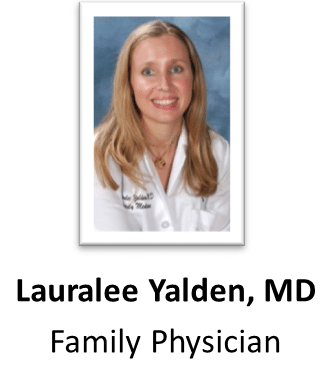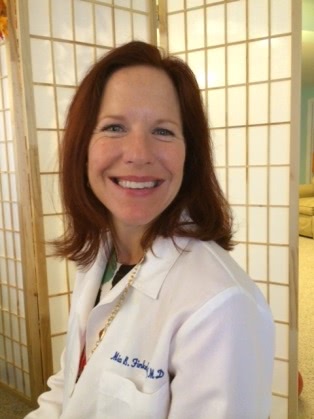The Virtual Doctor Is In
Did you know 57% of physicians are willing to see patients online? Amwell recently released our Telehealth Index: 2015 Physician Survey eBook, which shares insight into the key factors about telehealth identified by the survey as impor
tant to physicians. In conjunction with the release of our eBook, we held a webinar that included a Q&A session with Dr. Lauralee Yalden, an Online Care Group (OCG) doctor. Online Care Group is the national telehealth network of
providers that exclusively serves Amwell’s clients and staffs our consumer offering, Amwell. This post contains some insightful excerpts from that interview. If you’re interested in joining our upcoming Telehealth Index: 2015 Physician Survey webinar, you can register here. During the webinar, we will conduct a similar Q&A with another OCG doctor, Dr. Mia Finkelston.
 Dr. Lauralee Yalden is a board-certified Family Medicine physician and graduate of Ross University School of Medicine who has been in practice for over 10 years. She balances her time between providing online care for Amwell and working in the local emergency room at The Veterans Administration. Dr. Yalden is very active with the AAFP (American Academy of Family Physicians,) where she founded and chairs the AAFP Telehealth Member Interest Group.
Dr. Lauralee Yalden is a board-certified Family Medicine physician and graduate of Ross University School of Medicine who has been in practice for over 10 years. She balances her time between providing online care for Amwell and working in the local emergency room at The Veterans Administration. Dr. Yalden is very active with the AAFP (American Academy of Family Physicians,) where she founded and chairs the AAFP Telehealth Member Interest Group.
What motivated you to want to practice medicine online?
Dr. Yalden: I have been practicing online with the Online Care Group for three years, and initially it was just part of a big job search. I needed to move from Florida to New York City, so I did a very extensive search and was fortunate enough to learn about Amwell. I was very impressed by Amwell’s unique vision and forward-thinking ideas. As a family medicine physician, I was used to taking calls at all hours of the day and night from home. Being able to actually see the patients by video really adds to your diagnostic capabilities, and really offers a comprehensive evaluation, diagnosis and treatment plan.
How did you become trained to practice online?
Dr. Yalden: The training included a member of the Online Care Group staff coming down to my home in Florida and demonstrating the capabilities of the platform and the EHR. The EHR is very similar, and in many cases easier to use, than many of the other EHRs on which I’m trained. We reviewed all the different options that are available for communicating with the patient, went over good documentation, how to review a patient’s medical records, and how to access reading materials in order to offer patients the best treatment plan possible. All the training physicians also practiced with one another to simulate what it was like to see someone online. We took turns playing doctor and patient online to see what is was like diagnosing, evaluating and managing a patient. We were also doing our best to optimize our treatment for each individual condition.
How many patients do you see online?
Dr. Yalden: It really depends on the day, shift and number of physicians available. Typically, I work full-time day shifts and see two to three patients per hour. I am able to see 40-50 patients per week, but this number can vary. During cold and flu season the number is usually higher, and during weekends I tend to be busier.
As an individual doctor practicing within a medical group, how do you work together around developing clinical protocols?
Dr. Yalden: That’s a great question. Online Care Group is a very robust medical practice with full-time physicians spanning the entire United States. We come from different medical backgrounds, with the majority being primary care physicians—but we have physicians who are board-certified in emergency medicine, pediatrics, etc. We really work together as a group, meeting once a month and each serving on many different committees as part of the Online Care Group. One of our main objectives is to try to optimize our diagnoses and treatment of different medical conditions online. We discuss different medical conditions and develop templates and overall standards of care to practice medicine online. You do have to tailor your physician exam and questions to patients online, but we’re really seeking to answer the same questions and diagnose the same conditions as we do in a brick and mortar practice.
How did you adapt your practice for the online environment?
Dr. Yalden: I can give you an example of a patient case that I saw earlier today. It was a very nice mother and her son calling in with a case of conjunctivitis. This is something you would see in any office—pediatrics, primary care or online. Conjunctivitis is one of those conditions where you can really make an excellent diagnosis online. With mom’s help, we were able to do a good evaluation of her son. I was able to see the eye up close, and using the iPhone I could take a look inside the mouth at the tonsils. Mom was able to touch and feel for any lymph nodes, and she touched the ears to make sure there weren’t any other cold symptoms or aches and pains. Parents are very educated and knowledgeable about what is going on with their children. She had already taken his temperature and had a whole bunch of wonderful information even before she logged in. She had a very good sense of the child’s health, medical history and immunizations. It was wonderful to be able to provide this level of care at home. Mom was very excited about not having to take the time to go in and see the pediatrician, and she was happy to be able to do this online.
How would you handle a medical emergency if you were presented with one online?
Dr. Yalden: These kinds of things do happen from time to time exactly as they do in an office setting. Someone will connect with you online and they’re having chest pains or difficulty breathing, and by looking at them and getting a sense of their medical history you’re able to assess really quickly if these symptoms are more complicated than something you can manage online. In cases like that, I assess if the patient is in a safe environment, and figure out if they’re home alone or if there is a family member available to help—either by calling 911 or by taking that person to a higher level of care. There have been times where I’ve had to activate my 911 emergency protocols and stay on the line with the patient until the ambulance has arrived and picks up the care of the patient. The bottom line is we do have protocols in place for these types of situations.
 Interested in learning more? Join us on Thursday, December 17th at 2:30 pm for the 2015 Physician Survey Insights Webinar. Mary Modahl, Senior Vice President at Amwell, will review the research and share additional insights on the Physician Survey, while Online Care Group (OCG) doctor, Mia Finkelston, MD, answers your questions during a live Q&A.
Interested in learning more? Join us on Thursday, December 17th at 2:30 pm for the 2015 Physician Survey Insights Webinar. Mary Modahl, Senior Vice President at Amwell, will review the research and share additional insights on the Physician Survey, while Online Care Group (OCG) doctor, Mia Finkelston, MD, answers your questions during a live Q&A.


